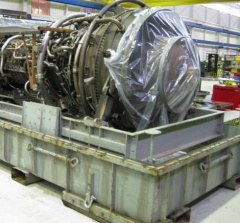Difference between revisions of "Aeroplane (parts)"
| Line 11: | Line 11: | ||
Parts used for the manufacturing of aircrafts consisting of a variety of small, large and odd sized and shaped items. | Parts used for the manufacturing of aircrafts consisting of a variety of small, large and odd sized and shaped items. | ||
<br> | <br> | ||
| − | |||
| − | |||
==Shipment / Storage== | ==Shipment / Storage== | ||
| − | Due to the sensitivity of air craft parts and their required high standard of quality, special manufacturers transport instructions are applicable. Manufacturers should be consulted for specific packing, handling and transport instructions | + | Due to the sensitivity of air craft parts and their required high standard of quality, special manufacturers transport instructions are applicable. Manufacturers should be consulted for specific packing, handling and transport instructions<br><br> |
| − | Smaller parts may be transported in packed form, whereby the packaging should be suitable and strong enough to protect the goods during transport. | + | Smaller parts may be transported in packed form, whereby the packaging should be suitable and strong enough to protect the goods during transport. <br><br> |
| − | Handling of smaller parts and packages should be so that these are kept upright during lifting, requiring proper application of lifting slings. | + | Handling of smaller parts and packages should be so that these are kept upright during lifting, requiring proper application of lifting slings. <br><br> |
| − | The way of application of the lifting slings is often marked on the packages and items, whereby the lifting points and the maximum or minimum required angles of the lifting gear is indicated. | + | The way of application of the lifting slings is often marked on the packages and items, whereby the lifting points and the maximum or minimum required angles of the lifting gear is indicated. <br><br> |
| − | Sufficient span should be maintained in the lifting gear, for example by means of spreaders keeping the slings upright and so avoiding crushing the upper edges of the items when handled. It is recommended to stow smaller items in pre slung condition, so avoiding the tilting or lifting of packages in case slings for a subsequent handling action are to be positioned. | + | Sufficient span should be maintained in the lifting gear, for example by means of spreaders keeping the slings upright and so avoiding crushing the upper edges of the items when handled. It is recommended to stow smaller items in pre slung condition, so avoiding the tilting or lifting of packages in case slings for a subsequent handling action are to be positioned.<br><br> |
| − | Large air craft parts are shipped either in packed or unpacked form, usually under instructions and special transport means developed by manufacturers or special freight forwarders and logistic service providers | + | Large air craft parts are shipped either in packed or unpacked form, usually under instructions and special transport means developed by manufacturers or special freight forwarders and logistic service providers. <br><br> |
Aircraft parts can be shipped in containers or as conventional cargo | Aircraft parts can be shipped in containers or as conventional cargo | ||
Revision as of 13:59, 16 November 2016
| Infobox on Aeroplane (parts) | |
|---|---|
| Example of Aeroplane (parts) |  |
| Facts | |
| Origin | Various |
| Stowage factor (in m3/t) | - |
| Humidity / moisture | - |
| Ventilation | - |
| Risk factors | See text |
Aeroplane (parts)
Description
Parts used for the manufacturing of aircrafts consisting of a variety of small, large and odd sized and shaped items.
Shipment / Storage
Due to the sensitivity of air craft parts and their required high standard of quality, special manufacturers transport instructions are applicable. Manufacturers should be consulted for specific packing, handling and transport instructions
Smaller parts may be transported in packed form, whereby the packaging should be suitable and strong enough to protect the goods during transport.
Handling of smaller parts and packages should be so that these are kept upright during lifting, requiring proper application of lifting slings.
The way of application of the lifting slings is often marked on the packages and items, whereby the lifting points and the maximum or minimum required angles of the lifting gear is indicated.
Sufficient span should be maintained in the lifting gear, for example by means of spreaders keeping the slings upright and so avoiding crushing the upper edges of the items when handled. It is recommended to stow smaller items in pre slung condition, so avoiding the tilting or lifting of packages in case slings for a subsequent handling action are to be positioned.
Large air craft parts are shipped either in packed or unpacked form, usually under instructions and special transport means developed by manufacturers or special freight forwarders and logistic service providers.
Aircraft parts can be shipped in containers or as conventional cargo
Risk factors
- Moisture damage
- Mechanical damage











